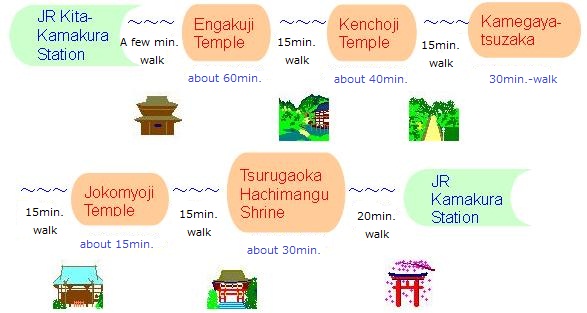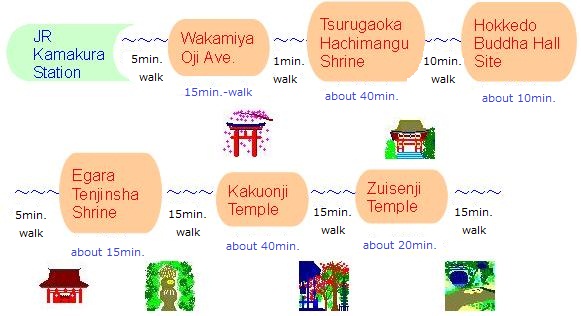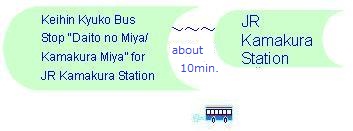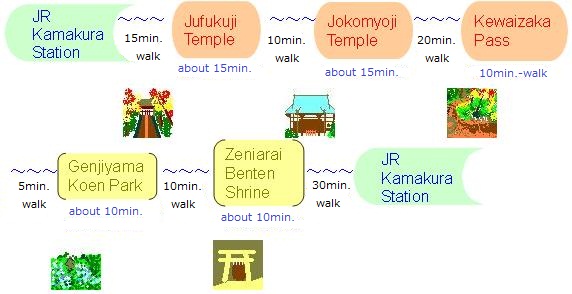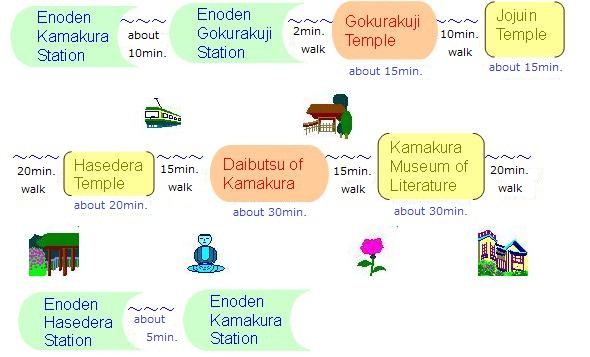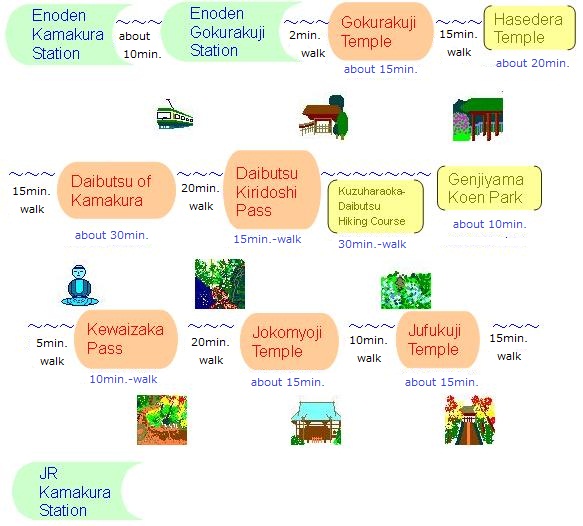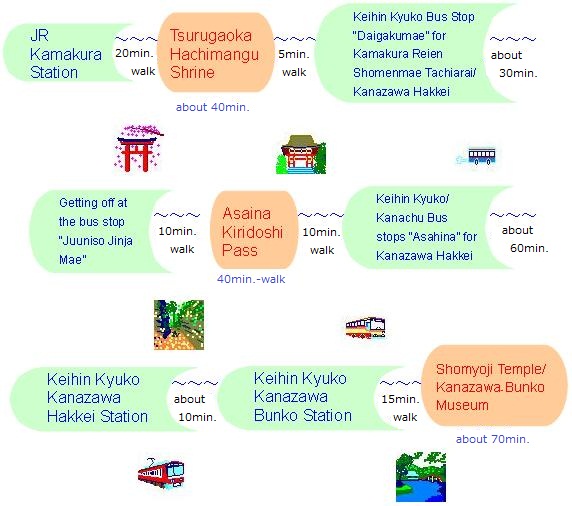ホーム > 教育・文化・スポーツ > 文化・芸術 > 文化財保護 > “Kamakura”- Aiming for Registration as a World Heritage Site > Access and Recommended Routes to Visit Cultural Properties that Constituted “Kamakura, Home of the Samurai”
更新日:2025年12月19日
ここから本文です。
Access and Recommended Routes to Visit Cultural Properties that Constituted “Kamakura, Home of the Samurai”
This page informs of access and model courses of “Kamakura, Home of the Samurai”
1. Recommended Routes
(1) Route for Good Walkers to Visit Main Shrines/Temples in Kamakura(North/Northwest Area)
(2) Route to Visit Tsurugaoka Hachimangu Shrine and Peaceful and Quiet Temples/Shrines(Northwest Area)
(3) Route for Good Walkers to Visit Temples/Shrines, Kewaizaka Pass and Genjiyama Park(Northwest Area)
(4) Route to Enjoy Daibutsu, Temples/Shrines,Beautiful Scenery andCulture course (Southwest Area)
(5) Route for Hiking to Visit Daibutsu Kiridoshi Pass,Daibutsu andTemples/Shrines (West Area)
To go to the page of cultural properties of "Kamakura, Home of the Samurai" with maps and the outline of the designated cultural properties, please click the properties'name.
--(1) Route for Good Walkers to Visit Main Shrines/Temples in Kamakura
(North/Northwest Area) --
Time Required : Approx.4 hours and 20 min. (2 hours' walk with ups and downs) Route Map1
Engakuji Temple It is a Zen Buddhist temple built by the eighth regent Hojo Tokimune. It consists of Shariden hall, Hojo Zen garden,etc. The buildings are arranged in a straight line of Garan layout in a narrow valley.
Kenchoji Temple It is the first Zen temple in Japan built by the fifth regent Hojo Tokiyori. Its buildings such as Sanmon gate, Butsuden and Hodo are lined up straight in a narrow valley, which is the characteristics of early Zen Buddhist temples. Also, the garden behind Hojo and a juniper of 750 years old can be seen here.
Kamegayatsuzaka It is one of the “Seven Passes of Kamakura”. The steep slope is still used as a community road.
Jokomyoji Temple It has the typical features of temples of Kamakura which were built in the valley. A big podocarpus tree of about 750 years old is amazing.
Tsurugaoka Hachimangu Shrine Its feature remains unchanged since the establishment by Minamoto-no-Yoritomo. Horseback archery (Yabusame) is held in every spring and autumn. Former The Museum of Modern Art in the compound are popular. The flowers and autumn leaves of Genpei pond are also beautiful.


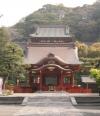 Tsurugaoka Hachimangu Shrine
Tsurugaoka Hachimangu Shrine
--(2) Route to Visit Tsurugaoka Hachimangu Shrine and
Peaceful and Quiet Temples/Shrines (Northwest Area) --
Time Required : Approx.3 hours and 25 min. (Approx.1 hour and 20 min.-walk) Route Map 2
Wakamiya Oji Ave. It is an avenue leading to Tsurugaoka Hachimangu Shrine, built by Minamoto-no-Yoritomo. He made this avenue for his wife Hojo Masako to pray for an easy delivery . The cherry blossoms and azaleas are beautiful.
Tsurugaoka Hachimangu Shrine Its feature remains unchanged since the establishment by "Minamoto-no-Yoritomo. Horseback archery (Yabusame) is held in every spring and autumn. Former The Museum of Modern Art in the compound are popular. The flowers and autumn leaves of Genpei pond are also beautiful.
Hokkedo Buddha Hall Site A religious space which enshrines Minamoto-no-Yoritomo, the founder of the Kamakura Shogunate. His tomb is located here.
Egara Tenjinsha Shrine It is one of the 3 major Tenjin shrines in Japan. The beautiful shrine pavilions, dedicated to Sugawara-no- Michizane are one of the oldest in Kamakura. There is also “Fudezuka (a mound to bury brushes that are used many years to express gratitude)” here. A famous cartoon artist's brushes are buried.
Kakuonji Temple The compound is built at the back of the valley and has tranquil religious atmosphere unique to the temples of Kamakura. Tours guided by the temple's monk are held for about 1 hour 5 to 6 times a day.
Zuisenji Temple The garden designed by Muso Soseki (one of the most famous monks, garden designer, etc. in Japan) is very famous. The fresh green leaves in spring and autumn colored leaves are beautiful. Mt. Fuji viewed from the top of the mountain is magnificent.
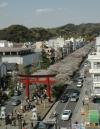 Wakamiya Oji Ave.
Wakamiya Oji Ave. 

 Zuisenji Temple
Zuisenji Temple
--(3) Route to Good Walkers to Visit Temples/Shrines, Kewaizaka Pass
and Genjiyama Park(Northwest Area) --
Time Required : Approx.2 hours and 30 min. (Approx.1 hour and 40 min.-walk with ups and downs) Route Map 3
Jufukuji Temple A Zen Buddhist temple built by Hojo Masako (Minamoto-no-Yoritomo's wife). Its approach is beautiful in all seasons.
Jokomyoji Temple It has the typical features of temples of Kamakura which were built in the valley. A big podocarpus tree of about 750 years old is amazing.
Kewaizaka Pass It is one of the “Seven Passes of Kamakura” and the north entrance of Kamakura. It was the strategic point and a place where Nitta Yoshisada (a samurai leader) staged an attack and had a fierce battle in 1333.
(Genjiyama Park) It is one of the beatiful sites where you can see cherry blossoms. The hydrangeas and autumn colored leaves are also beautiful.
(Zeniarai Benten Shrine) The spring water in the cave is one of the 5 best waters of Kamakura.



--(4) Route to Enjoy Daibutsu, Temples/Shrines, Beautiful Scenery
and Culture (Southwest Area) --
Time Required : Approx.3 hours and 30 min. (Approx.1 hour and 30 min.-walk) Route Map 4
Gokurakuji Temple The founder of this temple Ninsho’s Gorinto (a Buddhist pagoda) is open to the public on April 8 every year. The cherry blossoms and crape myrtles are beautiful.
(Jojuin Temple) The hydrangeas are beautiful.
(Hasedera Temple) The scenery viewed from the observatory in the compound, the seasonal flowers and Hase Kannon (a statue of a future Buddha that represents compassion, mercy and love) are wonderful.
Daibutsu (Great Buddha) of Kamakura The seated statue of Amida-butsu (Amitabha Buddha) is one of the national treasures in Japan. It was built approximately 750 years ago. It is one of the 3 biggest statues of Great Buddha in Japan. Its grandeur and strength represent the samurai culture.
(Kamakura Museum of Literature) The main building is a villa of the former marquis Maeda family. It is one of the biggest western-style architecture exsisting in Kamakura which was built before World War 2. It is registered as a tangible cultural property of Japan. The museum collects, stores and exhibits were hand-written manuscripts, letters favorite items, etc. of literary persons who were related to Kamakura.
 Gokurakuji Temple
Gokurakuji Temple 
--(5) Route for Hiking to Visit Daibutsu Kiridoshi Pass, Daibutsu
and Temples/Shrines (West Area) --
Time Required : Approx.4 hours and 40 min. (Approx.2 hours and 40 min.-walk with ups and downs) Route Map 5
Gokurakuji Temple The founder of this temple Ninsho's Gorinto (a Buddhist pagoda) is opened to the public on April 8 every year. The cherry blossoms and crape myrtles are beautiful.
(Hasedera Temple) The scenery viewed from the observatory in the compound, the seasonal flowers and Hase Kannon (a statue of a future Buddha that represents compassion, mercy and love) are wonderful.
Daibutsu (Great Buddha) of Kamakura The seated statue of Amida-butsu (Amitabha Buddha) is one of the national treasures in Japan. It was built approximately 750 years ago and still remains the same feature. It is one of the 3 biggest statues of Great Buddha in Japan. Its grandeur and strength represent the samurai culture.
Daibutsu Kiridoshi Pass It is one of the “Seven Passes of Kamakura” and the west entrance of the road leading from Kamakura to Kyoto. The path opened on the mountain has the atmosphere of old time.
(Genjiyama Park) It is one of the beatiful sites where you can see cherry blossoms. The hydrangeas and autumn colored leaves are also beautiful.
Kewaizaka Pass It is one of the “Seven Passes of Kamakura” and the north entrance of Kamakura. It was the strategic point and the place where Nitta Yoshisada (a samurai leader) staged an attack and had a fierce battle in 1333.
Jokomyoji Temple Tt has the typical feauters of temples of Kamakura which were built in the valley. A big podocarpus tree of about 750 years old is amazing.
Jufukuji Temple A Zen Buddhist temple built by Hojo Masako ( Minamoto-no-Yoritomo's wife). Its approach is beautiful in all seasons.
--(6) Route for Good Walkers to Visit Asaina Kiridoshi Pass
and Shomyoji Temple (Northeast Area/Kanazawa Area)--
Time Required : Approx.5 hours and 20 min. (Approx.2 hours’ walk with ups and downs) Route Map 6
Tsurugaoka Hachimangu Shrine Its feature remains unchanged since the establishment by Minamoto-no-Yoritomo. Horseback archery (Yabusame) is held in every spring and autumn. Former The Museum of Modern Art in the compound are popular. The flowers and autumn leaves of Genpei pond are also beautiful.
Asaina Kiridoshi Pass It is one of the “Seven Passes of Kamakura” and was the main road that connects Kamakura to the strategic point of Kanazawa in the east. It still has the atmosphere of old time. One of the 5 best waters in Kamakura of "Kajiwara-Tachiarai-Mizu" comes from here.
Shomyoji Temple This temple was built by Hojo Sanetoki, one of the most educated samurai of the Kamakura Shogunate. It has the Pure Land style garden which is restored to the original state. An old ginkgo tree of more than 800 years old is located here and the cherry blossoms are beautiful.
Kanazawa-Bunko Museum : It was a library for samurai that Hojo Sanetoki founded in the Kamakura period. The museum exhibits valuable cultural properties of the samurai culture.

 Shomyoji Temple
Shomyoji Temple
2.Access
--To Kamakura--
(1) JR Yokosuka Line : From Tokyo Station to Kamakura Station (about 60 min.)
From Tokyo Station to Kita-Kamakura Station (about 55 min.)
From Tokyo Station to Ofuna Station (about 50 min.)
East Exit(Shonan Monorail, Keihin Kyuko Bus, Enoden Bus)
Kasama Exit(Kanachu Bus)
→To Kamakura: Keihin Kyuko Bus (via Daibutsu-Mae bus stop), Enoden Bus
→To Kanazawa Hakkei: Kanachu Bus
→To Enoshima: Shonan Monorail, Enoden Bus
(2) Keihin Kyuko Line : From Shinagawa Station to Kanazawa-Hakkei Station (about 45 min.)
→To Kamakura by train(about 30 min.)
-From Keihin Kyuko Shin-Zushi(transfer to JR Yokosuka Line) to Kamakura
→To Kamakura by Keihin Kyuko Bus(about 60 – 90 mins)
(3) Car : From Yokohama/Yokosuka Road - Asahina IC –Yuigahama Parking(Park & Ride)
From Zushi IC – (Zuyo Toll Road – Route 134) – same as the above
From Hakone – (Seisho By-pass – Route 134) – same as the above
→Shuttle bus(Park & Ride) on most weekends –KamakuraStation
→Walk to Enoden Wadazuka/Yuigahama Station – for Enoshima/Fujisawa
(Daibutsu, Hasedera Temple, Gokurakuji Temple), or for Kamakura Station
 Enoshima Island
Enoshima Island
--To Shomyoji Temple/Kanazawa-Bunko Museum--
(1) Keihin Kyuko Line : Shinagawa –Kanazawa-Bunko(about 40 min.) →walk (about 12 min.)
(2) Car : Yokohama-Yokosuka Road – Asahina IC –Umi no Koen (Marine Park) Parking→walk (about 10 min.)
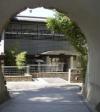 Kanazawa-Bunko Museum
Kanazawa-Bunko Museum
3.Transportationin Kamakura
--Public Transportation--
(1) Railroad : JR Yokosuka Line,Enoden Line (Kamakura- Enoshima-Fujisawa),
Shonan Monorail(Ofuna-Enoshima)
(2) Bus : Keihin Kyuko Bus,Enoden Bus
e.g. Keihin Kyuko Bus (No. 6) JR Kamakura Station – (Daibutsu-Mae bus stop)-Enoshima Station
Keihin Kyuko Bus (No. 40, 41) JR Kamakura Station – JR Zushi Station/Kotsubo
: Get off at a bus stop “Iijima” →to Wakaenoshima Port
Keihin Kyuko Bus (No. 30, 31) JR Kamakura Station –Shin-Zushi Station/Midorigaoka-Iriguchi
: Get off at a bus stop “Midorigaoka-Iriguchi” →to Nagoe Kiridoshi Pass
Enoden Bus JR Kamakura Station – (Kenchoji Temple) – JR Ofuna Station
(3) Park & Ride Shuttle Bus
Yuigahama Parking - Shuttle bus(Park & Ride) on most weekends –Kamakura Station
- Walk to Enoden Wadazuka/YuigahamaStation - for Enoshima/Fujisawa
(Daibutsu, Hasedera Temple, Gokurakuji Temple), or for KamakuraStation
 Yuigahama Parking
Yuigahama Parking
-- Others --
e.g.) ・ Rental bycicle
( For more infomation, contact the tourist informarion center in front of the east exit of JR Kamakura Station)
・ Taxi, etc.
4. Access to Accomodation Areas
-- From Kamakura to Odawara/Hakone --
From JR Kamakura Station (Yokosuka Line) - JR Ofuna Station (transfer to JR Tokaido Line) - JR Odawara Station (transfer to Hakone Tozan Railway) -Hakone-YumotoStation (Approx. 70 min. in total)
 Odawarajo Castle
Odawarajo Castle  Hakone
Hakone
-- From Kamakura to Yokohama--
From JR Kamakura Station (Yokosuka Line) - JR Yokohama Station (Approx. 30 min.)
 Yokohama Sankeien Garden
Yokohama Sankeien Garden  Yokohama China Town
Yokohama China Town
このページに関するお問い合わせ先
このページの所管所属は教育局 生涯学習部文化遺産課です。

